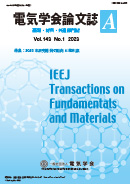
- |<
- <
- 1
- >
- >|
-
Teppei Kawaguchi, Tatsuya Sakoda, Takeshi Nishimura2023Volume 143Issue 2 Pages 46-53
Published: February 01, 2023
Released on J-STAGE: February 01, 2023
JOURNAL RESTRICTED ACCESSWe investigate the influence of electric field in a void of epoxy resin with fillers on development of electrical trees. Not only observations of pits and electrical trees but also measurements of temporal variations of the number of partial discharges (PDs) and the PD magnitude were carried out. It was found that PDs with several hundred pC can be measurement by a CT sensor until the obvious formation of an electric tree is achieved in the case of epoxy resin without fillers. Additionally, when electric field of the tip of a pit is the almost same as the withstand electric field of the epoxy resin, electrical tree and breakdown occur in a very short time. The development of electrical tree is disturbed by fillers in epoxy resin, and the required time for breakdown is much longer than that of epoxy resin without fillers.
View full abstractDownload PDF (2475K) -
Hideo Wada, Taito Fukawa, Kazuaki Toyota, Masatoshi Koyama, Nobuya Hir ...2023Volume 143Issue 2 Pages 54-62
Published: February 01, 2023
Released on J-STAGE: February 01, 2023
JOURNAL RESTRICTED ACCESSThis paper describes the deposition of Nb doped vanadium dioxide (VO2) films on a glass substrate by metal organic decomposition (MOD) and their thermochromic properties. The difference in thermochromic properties of VO2 thin films on a glass substrate was investigated with and without a buffer layer of Hf0.5Zr0.5O2 (HZO). The phase transition temperature of VO2 thin film successfully reduced from 83 to 43℃ on a glass substrate with a buffer layer of HZO. Without a buffer layer of HZO, the thermochromic properties of VO2 thin films deteriorated comparing with a buffer layer of HZO. HZO buffer layer effectively suppresses the miniaturization of VO2 crystallite size of thin film due to Nb doping. Moreover, it would block out the diffusion of Al, Na and Ca impurity ions from a glass substrate and the partial oxidation of VO2 thin films judging from XPS O1s spectra and XPS depth profile analysis. We conclude that the insertion of the HZO buffer layer is a useful technique for controlling the transition temperature of VO2 for the smart window applications by MOD.
View full abstractDownload PDF (1182K)
-
Haruaki Tanaka, Yunhai Cai, Hiroshi Tanabe, Yasushi Ono2023Volume 143Issue 2 Pages 63-64
Published: February 01, 2023
Released on J-STAGE: February 01, 2023
JOURNAL RESTRICTED ACCESSWe first observed the quadrupole structure of electrostatic potential during guide field reconnection in the region of two merging spherical tokamak plasmas. The toroidally symmetric electrostatic potential is generated globally in the downstream region of reconnection and increases with the reconnecting magnetic field.
View full abstractDownload PDF (997K) -
Masahiro Sato, Akiko Kumada, Kunihiko Hidaka, Takanori Yasuoka, Yoshik ...2023Volume 143Issue 2 Pages 65-66
Published: February 01, 2023
Released on J-STAGE: February 01, 2023
JOURNAL RESTRICTED ACCESSTo study the polarization characteristics of polymer/ferroelectric composites when applied to electrical insulation in power equipment, we develop a first-principles based empirical parameter free multi-scale modeling approach. In addition experiments are carried out to obtain the polarization-electric field (P-E) hysteresis loop of a commercial BaTiO3 single crystal. It is shown that the proposed computational model can successfully reproduce the experimental P-E loop when the domain wall motion is taken into account. The results strongly indicate that the domain wall motion is crucial for describing the P-E characteristics of ferroelectric fillers when used under low electric field (< 10 kV/mm) with long time scales (> 1 µs).
View full abstractDownload PDF (516K)
-
2023Volume 143Issue 2 Pages NL2_1
Published: February 01, 2023
Released on J-STAGE: February 01, 2023
JOURNAL FREE ACCESSDownload PDF (701K) -
[in Japanese]2023Volume 143Issue 2 Pages NL2_2
Published: February 01, 2023
Released on J-STAGE: February 01, 2023
JOURNAL FREE ACCESSDownload PDF (1412K) -
[in Japanese]2023Volume 143Issue 2 Pages NL2_3
Published: February 01, 2023
Released on J-STAGE: February 01, 2023
JOURNAL FREE ACCESSDownload PDF (1006K) -
2023Volume 143Issue 2 Pages NL2_4
Published: February 01, 2023
Released on J-STAGE: February 01, 2023
JOURNAL FREE ACCESSDownload PDF (522K)
-
2023Volume 143Issue 2 Pages L2_1
Published: February 01, 2023
Released on J-STAGE: February 01, 2023
JOURNAL FREE ACCESSDownload PDF (165K)
- |<
- <
- 1
- >
- >|